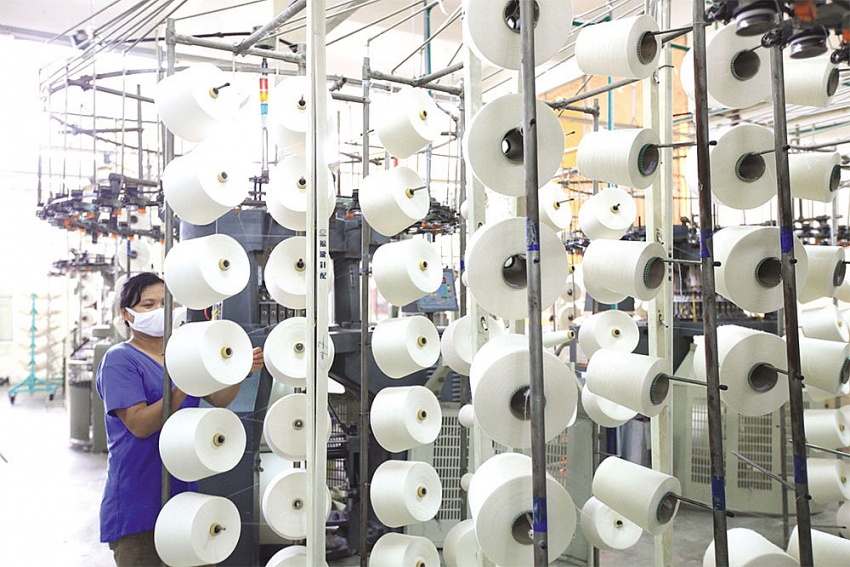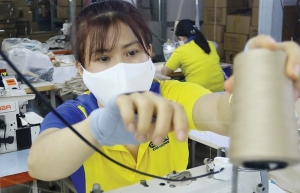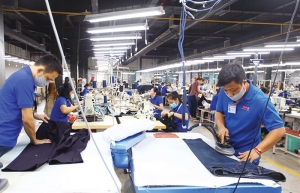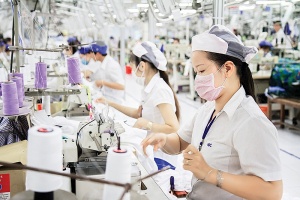Textile and garment groups feeling global squeeze
The rapid increase in the US consumer inflation to 9.1 per cent in June, a level not seen in more than four decades, has dragged down textile demand in the market during this half of the year. Inflation in the Euro area in July also set a new record at 8.9 per cent, a sign that people are reducing shopping.
Pham Van Viet, chairman of VitaJean Co., Ltd. in Ho Chi Minh City, said the company’s orders from the EU and US markets have decreased by about 40 per cent and may continue to decline until the first quarter of 2023. “I’m concerned that the Japanese market may also reduce purchases shortly,” Viet said. “We don’t have many new orders and are trying to maintain production to retain customers and employees. But our inventories increase, which is detrimental to us.”
 |
| Textile and garment groups feeling global squeeze |
Viet also noticed that the value of each batch of goods dropped sharply as the euro depreciated in comparison to the US dollar. European buyers pay in euros, and Vietnamese manufacturers must exchange them for US dollars to buy raw materials and invest in equipment.
Meanwhile, analysts at VNDIRECT reported on August 19 that the outlook for textile and garments would depend on controlling inflation in major export markets such as the United States and EU. Currently, 85 per cent of the revenue of textile companies comes from exports, of which the US and EU account for 61 per cent.
Large enterprises, such as Thanh Cong Textile and Garment JSC, Century Yarn JSC, and Damsan JSC have had enough orders for the third quarter of 2022, but some buyers have cancelled orders due to fears of high inventories in the fourth quarter of 2022 and concerns about inflation.
VNDIRECT believes that reduced demand and exchange rate risks will slow down the net profit growth momentum of garment companies in the final months of 2022.
The net profits of TNG Investment and Trading JSC and Song Hong Garment JSC decreased by 5-10 per cent in the second half of 2022 compared to the first six months of 2022 due to exchange rate losses alone.
Along with garment businesses, VNDIRECT believes that the gross profit margin of cotton yarn enterprises will decrease by 1-1.5 percentage points in the second half of 2022.
The company forecasts that demand for high-end clothing items such as shirts and T-shirts made from recycled fibres and cotton yarns will slow down in the second half of 2022.
Furthermore, yarn prices and fabric would cool down in the fourth quarter, following prices of other materials. In the third quarter, cotton prices have fallen 40 per cent from their peak in March after oil prices cooled down.
Longer-than-expected inflation in Europe and the US also led to a decrease in export orders from Vietnamese leather and footwear companies. As they do have not had many new orders for months, Taekwang Vina Industrial JSC, a fully South Korean-owned company, has informed all employees at branches in Dong Nai, My Tho, and Dak Lak provinces to arrange leave for the rest of 2022.
According to the firm’s chairman Dinh Sy Phuc, if employees have to use up all their leave in 2022, they will be able to choose between advancing the leave of 2023 or taking unpaid leave.
Diep Thanh Kiet, vice president of the Vietnam Leather, Footwear and Handbag Association, commented that domestic shoe businesses would be extremely worried about losing some of their labourers. “Meanwhile, foreign-owned shoe businesses are paying great attention to the movement of the world market, with some of them continuing to expand factories and upgrade equipment,” he said.
In Vietnam, leather and footwear exports are almost completely in the hands of foreign-invested enterprises (FIEs). According to updated and verified data by market intelligence platform Houselink, in 2021, FIEs accounted for more than 70 per cent of Vietnam’s total footwear import and export turnover, with the situation persisting for many years.
Kiet also pointed out that the average export price of Vietnamese shoes is no longer cheap, partly due to the increasing labour costs. The average price of these stands at about $17 per pair, while the average export price of European shoes is $25 and worldwide merely $9.
“Popular product lines are having to deal with low profit margins, which mainly come from labour. Meanwhile, in the high-end product line, the profit comes from creativity,” said Kiet.
“In this regard, manufacturers from China are doing better than their Vietnamese counterparts. They buy technology from other countries and invest in research and make their equipment, gradually replacing imported machinery,” he explained.
The coronavirus pandemic and the prolonged conflict in Ukraine continue to disrupt global value chains, forcing industries like textile and footwear to re-evaluate and adapt. Several analysts warned that the chances of the situation easing are quite low and companies need to prepare for the worst.
 | Textile groups in demand slump The challenge for Vietnam’s textile and garment exporters remains the high price of input materials, coupled with inflation that is reducing general shopping demand. |
 | Small textile groups left behind as big brands take on recycling Some of Vietnam’s biggest textile groups are picking up on the worldwide trend of utilising recycled materials, with several largest global brands increasingly switching to greener methods. |
 | Vietnamese textile and garment businesses facing compliance pressure Vietnam's textile and apparel manufacturers are stepping up their efforts to comply with international standards for origin traceability. |
What the stars mean:
★ Poor ★ ★ Promising ★★★ Good ★★★★ Very good ★★★★★ Exceptional
Related Contents
Latest News
More News
- Double-digit GDP growth within reach with shift to higher-value expansion (January 06, 2026 | 08:33)
- Takeda Vietnam awarded for ongoing support of Vietnam’s sustainability efforts (December 31, 2025 | 21:00)
- Vietnam's retail market tops $269 billion in 2025 amid e-commerce boom (December 31, 2025 | 19:00)
- Stronger legal framework urged as trade fraud surges online (December 31, 2025 | 18:58)
- FPT exports first chip shipment to Japan (December 31, 2025 | 10:47)
- AkzoNobel rolls out sustainability campaign “It All Adds Up” for the wood sector (December 31, 2025 | 09:23)
- Textile apparel firms deliver robust earnings despite global tariff pressures (December 30, 2025 | 10:09)
- Businesses ramp up production as year-end orders surge (December 30, 2025 | 10:05)
- Vietjet chairwoman awarded Labour Hero title (December 29, 2025 | 13:06)
- How to unlock ESG value through green innovation (December 29, 2025 | 10:03)

 Tag:
Tag:



















 Mobile Version
Mobile Version